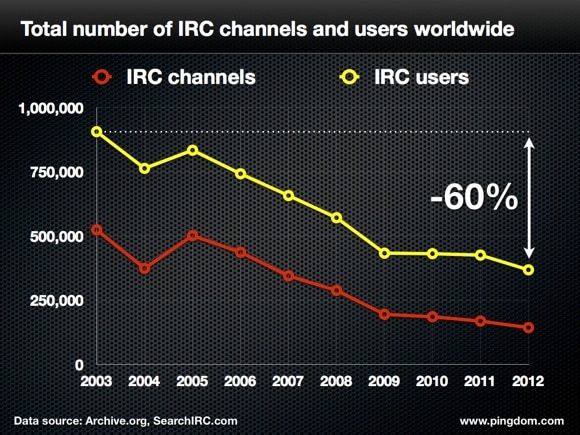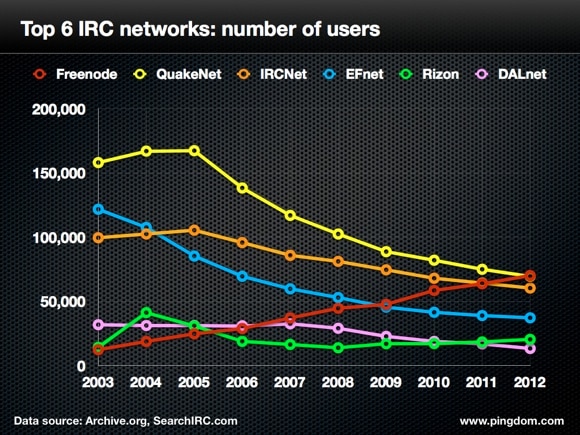 IRC (Internet Relay Chat) has been around since 1988, which makes it ancient in Internet terms.
IRC (Internet Relay Chat) has been around since 1988, which makes it ancient in Internet terms.
And although it’s still used by hundreds of thousands of users around the world, IRC has seen a dramatic downturn in usage.
We have talked to the creator of IRC, and others, about why the once so widely used technology has seemingly fallen out of favor with so many users.
The origins of IRC
We connected with Jarkko Oikarinen, the creator of IRC, who works at Google in Sweden, and he told us the story of how IRC was born.

Oikarinen says that he created IRC during three to four months in 1988 when he was a summer intern at the University of Oulu in Finland.
At the time, Oikarinen was maintaining a local BBS (Bulletin Board System) called OuluBox and the chat system there needed refreshing. While working on the updated chat system he also wanted to allow participants from the Internet who didn’t need to be logged in to OuluBox to participate in chat.
Thus, IRC was born.
Since then, IRC has served as an invaluable way of communicating for scores of users around the world. For almost whatever you’d like to discuss or get help with, there’s been an IRC network and channel that would serve your interests.
But since the arrival of the new century, IRC has dropped in popularity, with users moving to other forms of communication like the web and social media. We took a look at the numbers to see just how bad it is for IRC.
IRC has lost 60% of its users since 2003
It’s clear that overall IRC usage, both in terms of users as well as channels, has been in steady decline for many years. In fact, IRC has lost 60% of its users since 2003, a dramatic fall in numbers for any service.

Oikarinen attributes the decline in IRC to a trend of commercialization on the Internet.
“Companies want to bring users to their walled gardens,” he says, to ”keep the user’s profiles locked there and not make it easy for users to leave the garden and take their data with them.”
IRC’s distributed nature does not fit with the walled garden approach, says Oikarinen. So instead of supporting open communication tools like IRC, companies invest money in making their own solutions, he claims.
Christian Lederer, also known as “phrozen77,” is the webmaster of IRC-Junkie.org and he’s had his pulse on the IRC community for many years. According to Lederer, the decline in IRC usage has many possible reasons behind it:
- Lederer lists large and prolonged DDoS attacks in the early 2000s as one main reason behind the decline. The attacks disrupted many IRC networks, including the most popular ones, and crippled the chat experience for users. When the networks were back up again, many users had migrated elsewhere or abandoned IRC completely.
- Software piracy and the spreading of warez, is another reason Lederer points to. In the early days of IRC, finding such content was a major reason why some users connected to IRC networks. Over the years, users have found new and easier ways of obtaining warez, like P2P, resulting in less of a need for IRC.
- Social networking also played an important part of users fleeing IRC. With services like Facebook, Twitter, Linkedin, and others, users found it more convenient to communicate through the social network rather than logging in to an IRC channel.
- Finally, Lederer points to declining costs and increasing availability of cheap and reliable hosting. If someone disagreed with the way a network was run, they could suddenly start his or her own. In doing so, they could potentially take the channel they operated and their users with them, thereby decimating the numbers of the bigger networks even further.
So the decline in IRC usage is a complex issue with no straightforward answers. But it’s not all bad news, as we’ll see next.
Among top IRC networks, Freenode bucks the trend
If we look more closely at the top six IRC networks and chart their development since 2003, it’s clear there are winners and losers.

As you can see, QuakeNet, EFnet, and IRCNet have lost a lot of users, while DALnet and Rizon are floundering without moving much up or down.
But it’s not all doom and gloom in the world of IRC, however. Freenode.net is not following the typical trend. Rather it seems to be growing by leaps and bounds, up 486% from 2003 to 2012 in terms of users. According to Freenode’s blog, the network passed 80,000 concurrent connections on April 2, 2012.
In fact, Freenode has, according to these numbers, just become the number one IRC network in the world, just bypassing QuakeNet.

Christel Dahlskjaer, President of Peer-Directed Projects Center(PDPC), the organization that operates Freenode, explains the network’s growth with its focus on free and open source software.
“Freenode has indeed grown and continues to grow,” Dahlskjaer explains. “Freenode has never been a ‘traditional’ IRC network though. Our users tend to come to Freenode because they contribute to or use a free and open source (or other peer-directed) project that has a channel or more on the network. Then in turn other projects come to Freenode because there is a lot of overlap when it comes to users and contributors across the various projects.”
On the question of whether Freenode’s current good fortune is sustainable, Dahlskjaer is direct. “I see no reason to think that growth is likely to stall anytime soon. For the last six years at least, Freenode has been very steady,” she says.
Where is IRC headed?
It’s clear that IRC is declining in overall usage but growing in certain niche areas. Perhaps that’s where the future of IRC lies.
Lederer says that IRC has to innovate to compete with easy-to-use solutions such as Facebook. This, in turn, is driven by a change in mindset of developers of IRC-related software, who have to drive this innovation, client-wise as well as protocol and server-wise.
To Oikarinen,“more interoperability” with other systems such as 3D virtual worlds, multimedia, etc. is one “interesting path forward.” Oikarinen is no longer actively involved in the development of IRC, but he says that it’s up to individuals now.
Lederer makes a similar point, saying that some stand-alone clients are already pushing the boundaries of what is possible on IRC. He points to projects like KVIrc, which brought video chat to traditional IRC, as well as Konversation, with which several IRC users can share a virtual whiteboard.
Long live IRC
Although there’s no reason to think that IRC will disappear anytime soon, there’s also cause for concern about the future of the once so popular technology. Although Freenode can serve as an example of a growing IRC community, that, in and of itself does not mean the future is secure for IRC.
We at Pingdom recognize the tremendous value that IRC has brought to users around the world for many years, and hope that IRC will keep being widely used. In fact, we’ve just set up our own IRC server, which we have some exciting plans for.
Note about the data: We used the Internet Archive’s Wayback Machine to go back in time and look at how IRC has developed over recent years, using the data from SearchIRC.com. We’d like to point out that not all IRC networks are indexed by SearchIRC.com, the service we used to create the charts for this article. For example, Undernet is not a part of the SearchIRC index. We believe, however, that the general trend displayed by the SearchIRC data is correct. Top image via Shutterstock.
























